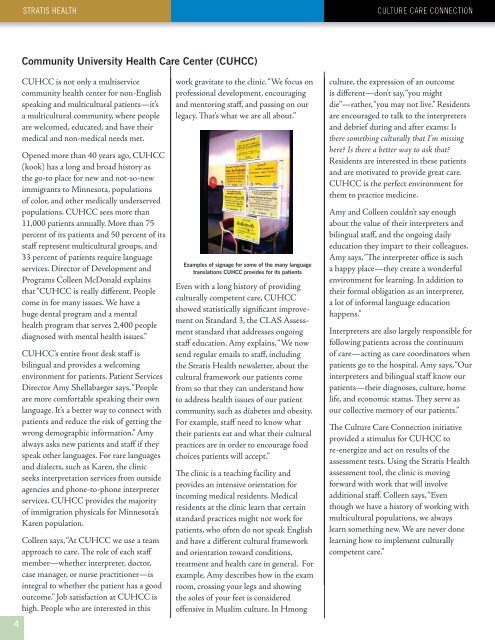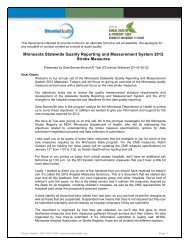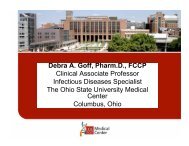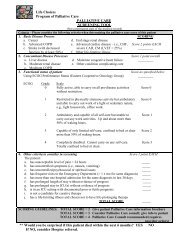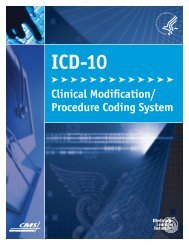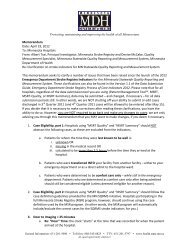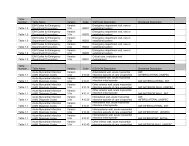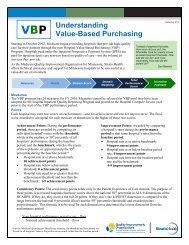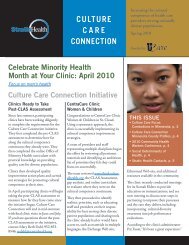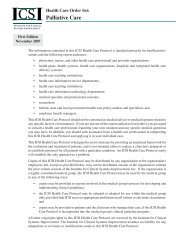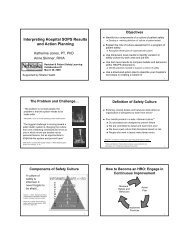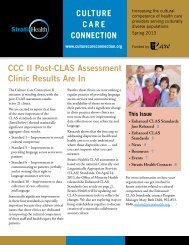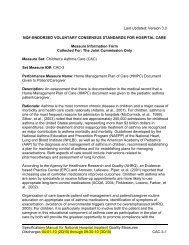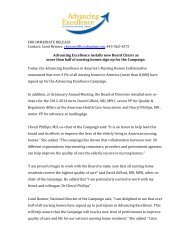Culture Care ConneCtion - Stratis Health
Culture Care ConneCtion - Stratis Health
Culture Care ConneCtion - Stratis Health
Create successful ePaper yourself
Turn your PDF publications into a flip-book with our unique Google optimized e-Paper software.
StratiS HealtH <strong>Culture</strong> <strong>Care</strong> <strong>ConneCtion</strong><br />
Community University <strong>Health</strong> <strong>Care</strong> Center (CUHCC)<br />
CUHCC is not only a multiservice<br />
community health center for non-English<br />
speaking and multicultural patients—it’s<br />
a multicultural community, where people<br />
are welcomed, educated, and have their<br />
medical and non-medical needs met.<br />
Opened more than 40 years ago, CUHCC<br />
(kook) has a long and broad history as<br />
the go-to place for new and not-so-new<br />
immigrants to Minnesota, populations<br />
of color, and other medically underserved<br />
populations. CUHCC sees more than<br />
11,000 patients annually. More than 75<br />
percent of its patients and 50 percent of its<br />
staff represent multicultural groups, and<br />
33 percent of patients require language<br />
services. Director of Development and<br />
Programs Colleen McDonald explains<br />
that “CUHCC is really different. People<br />
come in for many issues. We have a<br />
huge dental program and a mental<br />
health program that serves 2,400 people<br />
diagnosed with mental health issues.”<br />
CUHCC’s entire front desk staff is<br />
bilingual and provides a welcoming<br />
environment for patients. Patient Services<br />
Director Amy Shellabarger says, “People<br />
are more comfortable speaking their own<br />
language. It’s a better way to connect with<br />
patients and reduce the risk of getting the<br />
wrong demographic information.” Amy<br />
always asks new patients and staff if they<br />
speak other languages. For rare languages<br />
and dialects, such as Karen, the clinic<br />
seeks interpretation services from outside<br />
agencies and phone-to-phone interpreter<br />
services. CUHCC provides the majority<br />
of immigration physicals for Minnesota’s<br />
Karen population.<br />
Colleen says, “At CUHCC we use a team<br />
approach to care. The role of each staff<br />
member—whether interpreter, doctor,<br />
case manager, or nurse practitioner—is<br />
integral to whether the patient has a good<br />
outcome.” Job satisfaction at CUHCC is<br />
high. People who are interested in this<br />
work gravitate to the clinic. “We focus on<br />
professional development, encouraging<br />
and mentoring staff, and passing on our<br />
legacy. That’s what we are all about.”<br />
examples of signage for some of the many language<br />
translations CUHCC provides for its patients<br />
Even with a long history of providing<br />
culturally competent care, CUHCC<br />
showed statistically significant improvement<br />
on Standard 3, the CLAS Assessment<br />
standard that addresses ongoing<br />
staff education. Amy explains, “We now<br />
send regular emails to staff, including<br />
the <strong>Stratis</strong> <strong>Health</strong> newsletter, about the<br />
cultural framework our patients come<br />
from so that they can understand how<br />
to address health issues of our patient<br />
community, such as diabetes and obesity.<br />
For example, staff need to know what<br />
their patients eat and what their cultural<br />
practices are in order to encourage food<br />
choices patients will accept.”<br />
The clinic is a teaching facility and<br />
provides an intensive orientation for<br />
incoming medical residents. Medical<br />
residents at the clinic learn that certain<br />
standard practices might not work for<br />
patients, who often do not speak English<br />
and have a different cultural framework<br />
and orientation toward conditions,<br />
treatment and health care in general. For<br />
example, Amy describes how in the exam<br />
room, crossing your legs and showing<br />
the soles of your feet is considered<br />
offensive in Muslim culture. In Hmong<br />
culture, the expression of an outcome<br />
is different—don’t say, “you might<br />
die”—rather, “you may not live.” Residents<br />
are encouraged to talk to the interpreters<br />
and debrief during and after exams: Is<br />
there something culturally that I’m missing<br />
here? Is there a better way to ask that?<br />
Residents are interested in these patients<br />
and are motivated to provide great care.<br />
CUHCC is the perfect environment for<br />
them to practice medicine.<br />
Amy and Colleen couldn’t say enough<br />
about the value of their interpreters and<br />
bilingual staff, and the ongoing daily<br />
education they impart to their colleagues.<br />
Amy says, “The interpreter office is such<br />
a happy place—they create a wonderful<br />
environment for learning. In addition to<br />
their formal obligation as an interpreter,<br />
a lot of informal language education<br />
happens.”<br />
Interpreters are also largely responsible for<br />
following patients across the continuum<br />
of care—acting as care coordinators when<br />
patients go to the hospital. Amy says, “Our<br />
interpreters and bilingual staff know our<br />
patients—their diagnoses, culture, home<br />
life, and economic status. They serve as<br />
our collective memory of our patients.”<br />
The <strong>Culture</strong> <strong>Care</strong> Connection initiative<br />
provided a stimulus for CUHCC to<br />
re-energize and act on results of the<br />
assessment tests. Using the <strong>Stratis</strong> <strong>Health</strong><br />
assessment tool, the clinic is moving<br />
forward with work that will involve<br />
additional staff. Colleen says, “Even<br />
though we have a history of working with<br />
multicultural populations, we always<br />
learn something new. We are never done<br />
learning how to implement culturally<br />
competent care.”


